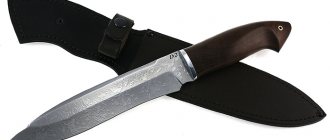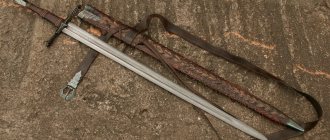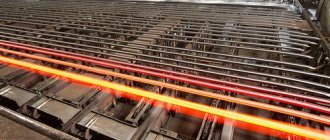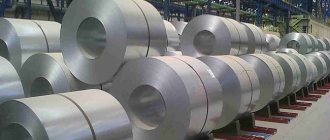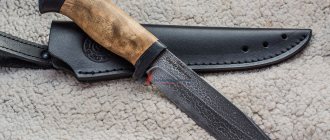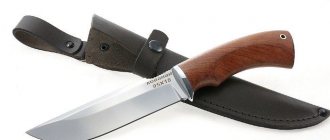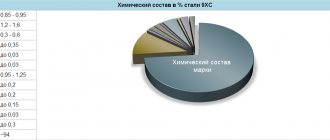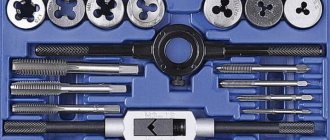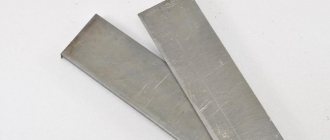History of the appearance of the alloy
Due to its unique characteristics, damask steel has always been more expensive than conventional alloys. Alloy knives and swords provided real advantages in battle. Such a product could cut the enemy's weapon. Steel blades became the subject of rumors and legends.
History of the creation of damask steel
There are no specific facts about the history of the creation of steel. But the first mentions date back to the times of Alexander the Great’s campaigns in India. It is from there that there is evidence of durable swords of Indian warriors. They easily cut through Macedonian weapons and armor.
Saber made of damask steel.
The only conclusion that comes to mind is that India was the historical homeland of damask steel.
And it appeared several centuries before our era. Archaeologists have found several centers in India where damask steel was made. Thanks to the development of trade, such products came to Syria and Persia.
In Central Asia, damask steel was called taban, khorasan and farand. But Timur's conquests led to the decline of this industry. As a result, by the 12th-14th centuries, the carefully protected methods of making damask steel were lost.
There are weapons and armor dating back to the 16th-18th centuries that were made from this steel. But it was a sample of the simplest damask steel, the technology of which was not complicated. And the quality of these items was an order of magnitude lower than the ancient products.
Bulat steel P.P. Anosova
Many craftsmen tried to revive steel production technology. And the famous metallurgist Pavel Petrovich Anosov succeeded in this matter. The head of the Zlatoust factories was very interested in the topic of damask steel. And in 1837, his works made it possible to recreate the alloy.
Return of a Legend
Closer to the beginning of the 20th century, the technologies developed by Anosov were again lost. A revival of interest in steel appeared again during the Soviet period. Experimentally, Anosov’s feat was repeated by metallurgist Sergei Baranov. Test melts allowed us to achieve the desired result. This was confirmed by the conclusion of the Russian Academy of Sciences.
Damask steel knives.
Iron Stream
At the beginning of the 18th century, Russian metallurgy began to develop rapidly. To implement his grandiose plans to expand the Russian state, Tsar Peter I needed a large number of high-quality weapons, and for their production they needed, first of all, iron and cast iron. Relying on domestic and foreign experience, Peter I organized iron ore mining and factory construction, unprecedented for that time. From 1700 to 1800, 123 ironworks were built in the Urals alone. By the end of the king’s life there were 233 of them, and by the end of the 18th century there were already 3,100 of them, not counting the mining factories. Pig iron production in Russia during this time increased from 150 thousand poods in 1700 to 9.91 million poods in 1800.
Abu-r-Raykhan Muhammad ibn Ahmad al-Biruni - Central Asian scientist-encyclopedist (4.09. 973 - 9.12.1048)
The victory of Russian metallurgy over Swedish was no less significant than the victory of the Russian army over the Swedes in 1721. For example, in 1716, the first batch of Russian iron in the amount of 2,200 pounds was exported to England, and in 1732, the export of iron already exceeded 200 thousand pounds. In 1722, a decree of Peter I was issued, which, in fact, gave the first technical conditions for the quality of iron:
“His Imperial Majesty ordered to send from the Berg College to all iron factories where iron is made, so that from now on the iron will be tested in this way, and released to the indicated places, and sold with the following marks.
First test: dig round pillars six inches thick in diameter into the ground so far that it is motionless, and hollow out holes in them the size of the strips, and push iron into that hole, and circle around that pillar three times, then back away from it. remove the post, and if it does not break, and there is no breaking mark, then stamp No. 1 on it in addition to the factory mark.
The second test: taking the iron strips, hit the anvil three times, then turn the other end back and hit them three times with all your might, and whichever one will withstand, and there will be no sign of a break, then each one, in addition to the factory mark, is branded with No. 2.
On the latter, which does not withstand those tests, put in addition to the factory stamps No. 3. And without stamps, strip iron should not be sold at all.”
Patterns of welding damask steel, enlarged 2-4 times
Each type of steel was rated according to its “own” number of “bends”: spring steel with six “bends”, coin steel with eight, tool and Damascus steel with twelve.
The leadership style of Peter I was also characterized by the strictest control over the implementation of his decrees. Thus, by decree dated January 11, 1723, he ordered: “The gun office from St. Petersburg should move to Tula and monitor the serviceability of the guns day and night. Let the clerks and clerks watch how Alderman places the brands. If you have doubts, check it yourself by inspection and shooting. And shoot two guns every month until they deteriorate. If a hitch occurs in the army, especially during a battle, due to the oversight of the clerks and clerks, the senior clerk will be given a job as a clerk, and the clerk will be deprived of his Sunday glass for a year.”
In the 18th century, Russia became the largest exporter of iron to Western Europe. In 1788 alone, 38.4 thousand tons of iron were exported from Russia to England and 5.8 thousand tons to other countries.
Zlatoust cavalry saber
In 1751, on November 20, the Tula industrialists Mosolovs entered into a contract with the Orenburg chancellery for the construction of an ironworks. In 1754, in the Kosotursky tract, on the Ai River, half a mile from the mouth of the Tesma River, the Zlatoust Plant was founded - one of the largest metallurgical plants in the Southern Urals. Having reached its design capacity, already in 1773 the plant was producing up to 140 thousand pounds of cast iron, 90 thousand pounds of iron and 1.885 thousand pounds of copper.
Over the course of 75 years, from 1701 to 1776, a whole complex of metallurgical plants was erected in the Urals: Nevyansky (1701), Kamensky (1701), Nizhne-Tagilsky (1725), Kononikolsky (1750), Preobrazhensky ( 1758), Verkhne-Avzyanopetrovsky (1755), Nizhne-Avzyanopetrovsky (1756), Katav-Ivanovsky (1757), Beloretsky (1761), Zlatoustovsky (1773), Miasssky (1776) . By the beginning of the 19th century, the Urals emerged as a grandiose industrial region on a global scale.
A copy of the saber of Tsar Mikhail Fedorovich, made by master gunsmith Ilya Prosvit.
Chemical composition and properties of damask steel
Thanks to a special manufacturing technology, damask steel has a unique internal structure. The alloy has high hardness and elasticity with a unique appearance. Bulat steel is an alloy of iron and carbon.
Due to the production features, the surface of the finished product has a beautiful pattern. This material has been used for the manufacture of bladed weapons since ancient times. The chemical composition of the alloy is closer to cast iron than to steel.
But at the same time it retains the malleability and ductility inherent in low-carbon steels. But the high carbon content of about 2% makes the alloy incredibly hard. Ordinary metals cannot achieve such hardness, even after hardening.
Damask steel reaches a value of 70 HRC, the result is more than worthy. The unique pattern on the blade and the beautiful cut will not leave any knife lover indifferent.
Pros and cons of steel
The main properties and features of damask steel are primarily determined by the carbon content in the alloy. An important role is played by the temperature values that are achieved during the steel melting process. If you overheat the raw materials, the result will be disastrous.
The production of damask steel is a complex process.
When making knives, it is necessary to connect metal packages to each other using forge-type welding. Thanks to this technology, a characteristic structure consisting of several layers is obtained.
To achieve the planned results, it is necessary to implement correct annealing and act strictly according to the recipe. Manufacturing tricks ensure high quality products. Let's see what advantages and disadvantages they have:
pros
- this type of steel withstands mechanical shocks and bending loads very well;
- damask steel is a highly hard material that is characterized by increased wear resistance;
- this alloy has a very long service life, the material can last for decades;
- damask steel is characterized by excellent cutting abilities; the metal makes wonderful knives;
- steel is capable of holding an edge on a knife for a very long time; once the product is sharpened, it can be used for a very long time without problems;
- beauty and sophistication of products, indescribable and unique patterns on the surface.
Minuses
- Damask steel blades are very difficult to sharpen. Greater hardness of the material will require special devices and knowledge;
- the type of steel in question cannot boast of high corrosion properties; a metal blade may begin to rust;
- the complex production process affects the cost of finished products.
Knife blades made of damask steel.
Bottom line
There are two main factors in obtaining damask steel: the purity of the metal and its crystallization, and the results of this work are like variants of a chess game. Since the purity of the metal is the most important factor, it is now difficult to find modern damask steel that is equal in strength and cutting properties to foreign knife steels (Sweden, Germany, Japan). My statement is not unfounded, since I bought the best knife steels, forged them, and then compared them. The list is long: from 440 C , ATS - 34 to all CPM and Hitachi.
Damask steel, smelted today in an induction furnace, or in a hole under an apple tree, does not even reach the level of ShKh-15. After all, if you live not in the virtual world of the damask pattern, but in reality, then damask steel must be superior to steel in strength and cutting, otherwise you should not use it. Therefore, after smelting the wutz and forging it, go to the laboratory of the nearest Tyazhmashzavod, find out the dimensions of the metal samples for testing (usually 30mm by 5mm), prepare the samples and test them for tensile, compression, fracture, torsion, shear, hardness. There are test tables for all steels. Find what steel your damask steel matches. If it is not possible to check at the factory, at least check two parameters at the forge: fracture strength and cutting properties. If an ingot of metal C = 2% is smelted and it is well forged, then it can be steel, damask steel, or a mixture of iron and cast iron filings. If C = 2.5%, then steel is excluded, leaving two options. At C=3%, it can only be damask steel. A mixture of sawdust with this carbon content is not malleable. So the level of 3% carbon can be considered as a filter, a certain threshold through which only damask steel is allowed to pass. Overheated damask steel does not turn into cast iron, cementite simply decomposes at a temperature of 738 degrees into graphite and ferrite, the seams between the grains become empty with graphite flakes, the feeling is that cementite has leaked out of the seams. This occurs at the transition from yellow to light yellow (1150 degrees). Therefore, if the damask steel was overheated to 1050 degrees, noticed in time and did not knock, then nothing will happen. And overheating to 1150 degrees destroys damask steel completely: the seams become dry, with air. Malleable damask steel (i.e. pure) is one that is forged at 850 degrees (scarlet color, transition to orange), a pattern appears on the surface when heated. Now you shouldn’t expect anything fabulous from damask steel. If hundreds of years ago, damask steel, being pure crucible steel, easily won the competition with cast iron and welded steel, now it competes with the same damask steel. So damask steel at C = 1.8% is equal to U9A steel, and even then, provided that it is perfectly welded, i.e. purified and transcrystallization achieved. And damask steel C=2% may be inferior in all respects to foreign steel C=1.2%, since it is much cleaner. I don’t think that these statements will discourage anyone from engaging in damask steel, since maniacs are deaf to evidence and arguments (I’m the same), moreover, I hope that I helped save time, especially at the initial stage. There is no mystery of damask steel, there are only difficulties in technological execution: to achieve purity and crystallization. It’s like a good tightrope walker would tell you that there are no secrets to working on a tightrope: just keep your balance and not be afraid. I don’t know if this information would be enough for you to walk on a tightrope without a safety net at a height of five meters. P.P. Anosov noted (on page 2 of his work) that “there is a lot of chatter about damask steel, but there is no result.” Therefore, I present my results (not all at once, since it sometimes takes a month to create one).
Alloy characteristics
According to its characteristics and structure, damask steel is a composite that is chemically and physically structurally heterogeneous. There is a theory that the role of a matrix in the metal is played by a soft plastic base of ferrite.
Iron carbide gives the alloy high viscosity. Self-sharpening is due to the wear resistance of the blade.
The soft fibers grind off on the cutting edge, and fibers with cementite come to the surface. This principle forms a micropyle.
And it already provides the ripping principle of cutting. It is very difficult to bend damask steel, but if it succeeds, the bend can reach an angle of 120 degrees. And after that the steel will straighten and retain its properties. Sharpening a damask steel blade is a rather lengthy and not easy process.
The mythical tests of cutting horsehair and a scarf in the air with a knife really take place. And at the same time, the sharpness of the blade remains for a very long time. The patterns on the surface of the blade can be striped, wavy or mesh.
The more complex the design, the higher the cost of the blade. It is formed during cooling. Damask knives are not made with engravings or designs; their natural beauty is at its best.
Examples of knives made of damask steel.
A matter of national importance
In 1828, the government set the task: “At the Zlatoust arms factory, introduce the manufacture of sabers of equal quality to those made in Asia.” Soon the tsar was informed that “the best craftsman in Tiflis, Karamon Eliazaroshvili,” had pledged to reveal the “hereditary secret” he had received from his father Geurg (George) and “teach people to make weapons using this secret.” As a test, he made sabers and daggers from “real” (i.e. cast) and “in the manner of damask steel” (i.e. welding damask steel). At the same time, the master used both “Indian iron” and “Turkish steel”. “Turkish cast iron powder” is a traditional raw material that his ancestors dealt with in Erzurum. Thus, in 1833, the craftsmen of the Zlatoust state-owned factories were able to make weapons from welding damask steel, using iron and steel from domestic factories. “It is impossible not to recognize in Eliazaroshvili’s welding blades,” contemporaries responded, “a high dignity for sabers, which is proven by the very test often used on them, namely cutting off the head of a bull with one blow.” Eliazaroshvili himself received a thousand chervonets as a gift and was awarded a gold medal.
The Zlatoust plant was a metallurgical enterprise with a full cycle. The plant smelted cast iron from which hammers, anvils, wheels, cannonballs, bombs, weights, pots, pans and other household utensils were cast. In total, he produced 11 types of iron and steel.
Zlatoust dragoon officer's saber, model 1881
In 1812, a special white weapons factory was founded at the Zlatoust plant, which in 1816 sent the first batch of edged weapons along the Ai River. Soon Zlatoust became widely known for making mainly sabers of the “Damascus” type (welding damask steel). Ironically, these sabers were for some reason known as “Turkish”. In addition to sabers, the plant's weapons factory produced checkers, broadswords, sapper and high-quality hunting knives, which were famous far beyond the borders of Russia. However, tool steel was inferior in quality to English steel: cast steel was not yet produced at the plant.
Scope of application of damask steel
Bulat steel is used mainly for making knives. They are made for various purposes and types. Today on the market you can find products for hunting or fishing. There are not only tourist products, but also military ones.
Throwing knives are made from this metal. Collectible knives are also made from steel. Such products can be very expensive. The handles of such knives are made mainly from natural materials. They may contain decorative stones and inserts made of precious metals.
Collectible knives are made only by hand. For this reason, products cannot be cheap. But unfortunately, the material in question could not receive proper distribution in other areas. In many other indicators, damask steel is inferior to modern alloy steel.
Do you already have a damask steel knife?
Not really
The difference between crucible damask steel and welded steel
To obtain high-quality damask steel, there are several types of production. But experienced blacksmiths keep them secret. It is important to understand that damask steel is not a secret chemical formula, but the correct sequence of heating and melting.
After the billet leaves the furnace, damask steel with a developed dendritic lattice is obtained. It can be seen with the naked eye. Today you can find two main methods of producing damask steel:
Production methods and materials
The secret of damask steel production has been revealed. It turned out that it was simple cast steel, obtained by alloying two types of iron. The secret thanks to which the blade received its characteristics was proper heat treatment:
- The metal was heated to a certain temperature;
- It was then slowly cooled.
- A crystallization effect occurred: cementite formed throughout the depth of the blade, as a result of which the steel became strong.
- They forged it with a lightweight hammer so as not to damage the cementite crystals that appeared.
It turns out that the difficulty lies not in the selection of source materials, but in the reproduction of the required temperature and the careful work of the blacksmith with steel.
Types of damask steel knives
The patterns on the blade do not always indicate that you have damask steel in your hands; it could also be damascus. The unique properties of damask steel have found application in knives. Today, such products are manufactured mainly by small workshops. The industry considers the alloy to be irrelevant.
There is no large scale production of knives. This is due to the fact that the manufacturing process is complex and there is no great need for such blades on the market. Alloy production is considered a delicate process, which is quite difficult to put on a conveyor belt.
Combat
Most of these items are made for collectors. Real life application is not intended. Knives of this type are made with decorative inserts and handles. Products are also susceptible to corrosion; they are treated with a special compound before storage.
Basically, these knives are made to order. Combat knives and swords can copy various designs from bygone eras. The use of such products in combat remains questionable. For army and airborne missions, the properties of damask steel are not in demand.
Damask steel combat knives.
Folding knives
Folding knives made of damask steel are quite rare. In most cases, blades made of Damascus steel or etched to look like damask steel are sold under their guise. Real folding knives are made from damask steel, made to order and they are not cheap.
Such products have all the properties of damask steel, but have a number of disadvantages. A regular sharpening stone cannot sharpen a blade. The process may take several hours. Although the dulling of the product occurs many times slower.
The use of a folding knife made of damask steel also has many problems. You need to take care of the knife, otherwise it will quickly begin to rust. You can etch the knife with lemon juice, but the pattern of the steel will be damaged. You can order a blade made of stainless steel, but it will be twice as expensive.
Folding products made of damask steel.
Hunting
Such knives are also mainly purchased for collections, and not for practical use. This is due to the fact that the blade does not resist corrosion well and needs to be sharpened for a long time. When sharpening a knife, you should act slowly and avoid scratching the blade. The process uses diamond abrasive stones.
Hunting knives made of damask steel.
Kitchen
Kitchen products are not widely used, for the same reasons as other knives. When choosing a product, you should pay attention to the following points:
- knives made from ordinary damask steel are highly susceptible to corrosion, they will require careful care;
- All products are made individually; there are simply no serial blades;
- A simple sharpener cannot sharpen such a blade and the process will take at least two hours;
- a kitchen product will be comparable in cost to a hunting knife.
For kitchen work, it is recommended to use stainless steel. But keep in mind that its cost will increase and it is difficult to find a master who will take on such work.
Sets of kitchen knives made of damask steel.
Does damask steel rust?
Bulat is susceptible to corrosion and requires careful care. Due to its weak resistance, the knife must be thoroughly cleaned and wiped after each use.
For removal, use rags, plus use alkaline oils (or neutral types). In an environment with high humidity, the blade should be wiped with Vaseline after each use for preventive purposes.
But some craftsmen (for example, P. Pampukha) were able to produce stainless damask steel by adding a number of additional elements to it. But the cost of such a knife is many times higher.
How does a damask steel knife work against alloy steels?
A properly sharpened damask steel knife will outperform any alloy product. Many people argue about the benefits of damask steel. To demonstrate aggressive cutting, a rope is cut. The tested products were sharpened at 20 degrees.
The test shows fantastic results; a damask steel blade outperformed alloy steel three times in terms of the number of pieces cut. In a specific case, we can say that damask steel blades are truly superior to ordinary knives.
What to look for when choosing
To purchase a normal damask steel product, you should pay attention to the following things:
- The monolithic damask steel rings clearly and continuously. If the blade is not solid, but consists of layers of fluctuations of various types, then the sound will be low and short.
- Pay attention to the assembly of the knife, it should be without gaps and there should be no burrs on the blade.
- The drawing should be chaotic on a dark background. Lines and dots should be clear and large in nature. If the lines are large, smooth and symmetrical, then you have Damascus.
- From a responsible manufacturer, the specified parameters of the weight and size of the blade must match the real product.
- Check the availability of documents - certificate and warranty card.
Which knives did you like best?
HuntingKitchen
Sharpening features
Believing that a damask steel knife will never become dull is, at the very least, stupid. Any product will have to be sharpened sooner or later. Although damask steel is distinguished by its stable cutting edge, it will still have to be sharpened. This process has its own characteristics:
- the blade should be sharpened at the required angle; it is best to maintain the angle that the master set for it at the very beginning;
- Please note that it will take a lot of time and effort to sharpen the product, the blade is very hard;
- Large grain stones will not work here; you will need Japanese water or diamond stones.
The history of damask steel
Damask knives, like other weapons made from this material, have been known since ancient times. There is a common misconception that the first mention of damask steel was noted in Ancient India.
There, local blacksmiths learned to forge “wootz” - an unusually strong, but at the same time flexible material. There are several legends associated with this material that bear little resemblance to the truth:
- Indian craftsmen added various materials to hot steel to give it the required shade, for example, copper sulfate powder;
- There were sabers made of damask steel that could be worn as a belt. Although, of course, it is unlikely that steel could be so flexible;
- arms sellers cut damask ingots in half to demonstrate to people the quality of the craftsman's work.
However, for the first time in history, this material was mentioned in Ancient Greece. Bulat in general, by the way, is often confused with Damascus steel.
There is a common misconception that the blade can have the same patterns as on weapons made of Damascus; the production technology itself excludes this possibility.
Other unscrupulous sellers take advantage of buyers’ ignorance and, under the guise of damask steel, sell ordinary steel, on which a similar design is applied.
In the “Tale of Igor’s Campaign” (XII century) it is said that the army of Vsevolod, Prince of Trubchevsky and Kursk, fought with the Polovtsians with damask swords. Damask steel was also mentioned in Russian documents from the 16th and 17th centuries.
Metallurgist Pavel Anosov is considered to be the first to recreate the technology of damask steel production in our country after a long time. He spent many years, but in 1837 he was able to reproduce the technology for producing damask steel, which had the properties described in early historical evidence.
However, P. Anosov did not leave information about how he received the “Russian damask steel”. Along with his death, forging technology was lost again, but only for a while.
Rules of use and care
For proper use of the products, you must follow the following rules:
- After using a knife, it should be rinsed in running water and wiped dry.
- The damask steel blade should be stored in a warm and dry place, the possibility of condensation should be excluded.
- For long-term storage, use a leather case and cover the blade with paraffin.
- If pockets of rust appear, use kerosene against it. Strongly aggressive substances are contraindicated.
Knife blades made of damask steel.
Demand for weapons made of damask steel
Weapons and household products made from damask steel are in constant demand. Despite the emergence of modern alloys, damask steel remains desirable among collectors, hunters and ordinary people. Today steel can be called a real brand.
Damask steel is only suitable for making knives. She doesn’t find herself in other industries. But it should be noted that there are a lot of low quality fakes on the market. And such knives are only suitable as a decorative item.
It should be noted that the production of real damask steel is quite difficult. For this reason, the products are very expensive. It will not be possible to make such a knife in a simple garage. But there are simply no blanks in the form of bars on the market.
Steel knives
Bulat is a collective name for hard and viscous alloys of iron and carbon. Chemically, damask steel differs from steel in the quantitative carbon content. This alloy is characterized by the fact that it has good impact strength, is able to resist corrosion for a long time and at the same time keeps the cutting edge sharp for a long time.
Knife – Veles
The Veles knife is a powerful tool for rough work. The knife has a through-type mounting, which means that the shank reaches the end of the handle. This gives the knife greater reliability. Supplied with a traditional leather sheath with vertical suspension. Product characteristics:
- Knife length: 275 mm;
- Blade length: 145 mm;
- Handle length: 130 mm;
- Butt thickness: 2.2 mm;
- Blade steel: Bulat;
- Handle material: Wood;
- Manufacturer: Bulat LLC, Russia;
- Weight: 188 grams.
Blade for rough work.
Kitchen knife – Chef
A handmade knife from Zlatoust craftsmen guarantees high quality and long service life. The handle is made of stabilized wood, the guard is made of carbon. Pins are inserted to decorate the handle. The blade is made of damask steel, which is famous for its good cutting and ability to hold an edge for a long time. Knife characteristics:
- Steel: Cast damask steel;
- Handle: Stabilized burl;
- Total length: 325;
- Blade length: 190;
- Blade width: 46;
- Blade thickness: 3.5;
- Blade hardness: 62 HRC.
A knife for working in the kitchen.
Knife – Cherry (NR-43)
An excellent replica of a scout knife from Zlatoust craftsmen, the knife is made of high-quality materials and the famous damask steel. The handle is made of micarta in “military” color with inserts of ebonite and nickel silver. The guard is made of stainless steel, and the butt is made of titanium. The kit includes a key for disassembling the knife. Product characteristics:
- Steel: Cast damask steel;
- Handle: Micarta;
- Total length: 270;
- Blade length: 157;
- Blade width: 24;
- Blade thickness: 4.0;
- Blade hardness: 62-64 HRC.
Military knife - cherry.
